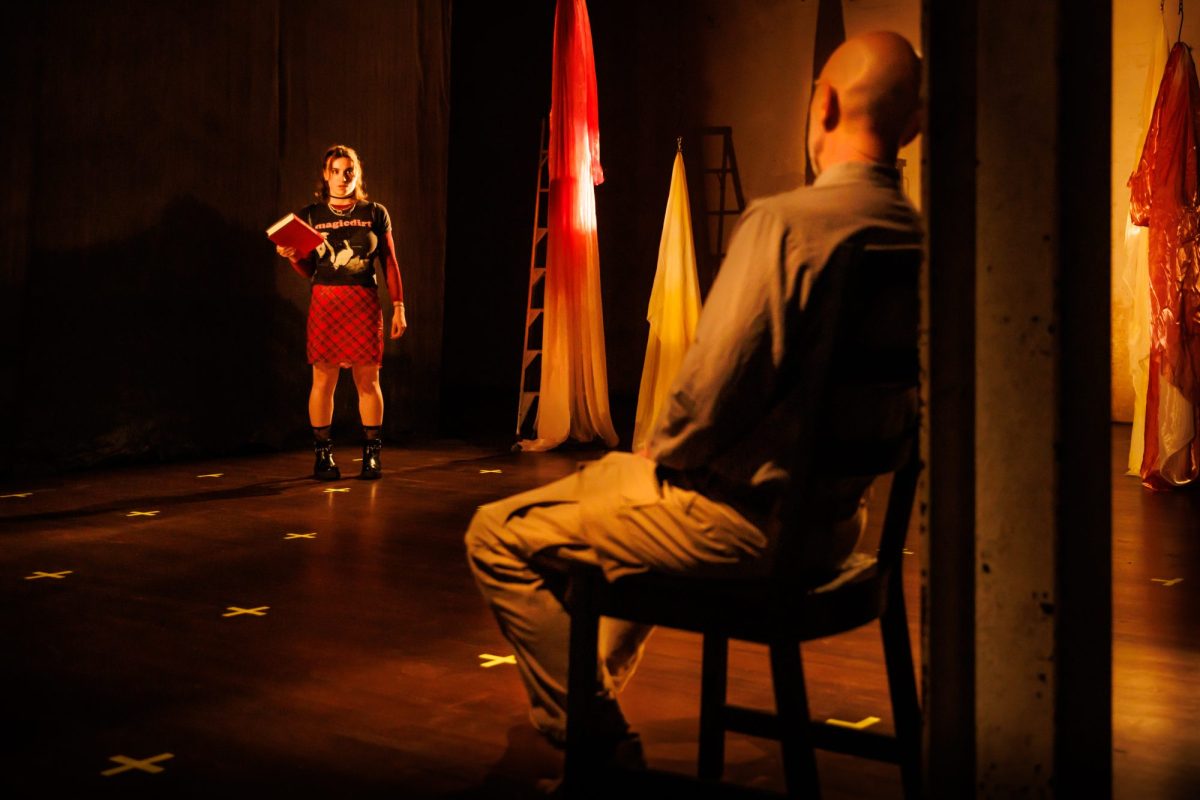Bridget Mackay’s new play The Exact Dimensions of Hell, explores the abusive relationship that develops between a 14-year-old girl and an older man, and lays bare the grooming process that leads to the abuse.
Set in the late 90s, it’s the era of The Craft and the girl is dressed in Fairuza Balk-lite baby-goth/punk attire – red tartan mini, Magic Dirt tee. She wants to learn the art of witchcraft and is searching for a mentor.
The first 10 minutes of the play are told through projected text appearing on a large screen at the rear of the stage. It’s a chat forum, and Lun4c4t is asking for anyone that can help her in her quest to find a witchy teacher. Her discussions lead her to Gr8tbeast. They arrange to meet. Despite effectively conjuring the nostalgic thrill of meeting random strangers in MSN messenger chat forums in the 90s as the start of a play, the 10 minutes feels about eight minutes too long.
The pair meet – Gr8beast is a middle-aged man, and it turns out he’s dying of cancer. He has written books on witchcraft and plans to write another before he dies. He’s divorced and refers to his ex as his former muse. ‘What happened?’ says the girl. ‘She got too old,’ says the man, in one of a number of red-flag comments (if an older bloke meeting a teenage girl from the internet wasn’t a big enough one).
The action of the play takes place on a bare, square stage, lit with cross lighting, surrounded by hanging drapey fabric and sectioned with white masking tape crosses placed in a grid, spaced about a metre from each other. The crosses look like spike marks that help actors and stagehands place props – and it’s clear they do serve this functional purpose later in the play, when the actors move across the stage, placing themselves between marks, as they are lit with overhead coloured spots. These lighting states serve to speed up the action of the play, delivering scenes in quick cuts, each lighting change indicating a different moment.
The screen at the back of the stage also is used throughout the play to heighten moments of drama and reinforce the witchcraft discussed and explored in the play. In one charged scene, the girl rides a euphoric wave of power, generated by the spell the two cast together, before the moment turns to horror as the man takes advantage of this moment to sexually abuse the girl. The lights and moving abstract projections shift from passionate red to stark white, before the girl, now stony-faced, asks the man to stop. It’s a shocking moment, and expertly directed.
Where the projections feel less successful is where they are used to illustrate the spell structure – the man explains that a spell of desire is cast when a statement of desire is created, the vowels removed from the statement, and the remaining letters used to create a sigil. This process is illustrated again and again later in the play, as the girl casts her spells of desire, coming to terms with the abuse that she has endured – but it doesn’t add anything.
The two actors deliver strong performances. Particularly Matilda Gibbs as the girl, who manages to capture that vital energy of a young woman in that charged and vulnerable period of adolescence: without experience, but desperately seeking to find purpose and meaning, and carve her own destiny.
As the man Daniel Schlusser treads a challenging tightrope, performing a villainous character, without descending into caricature, erring on underplaying rather than overplaying. In his daggy beige belted pants, his tucked-in shirt and with his restrained performance, it requires some imagination to see him as the charismatic powerful witch-mentor that the girl sees in him – but that is the glamour cast by an experienced a sexual predator in sheep’s clothing.
For a new play, I did wonder why it was set in 1998. Is it because this is before the time when we would expect this girl to learn witchcraft from YouTube videos? Or to solve the problem of why her mum wasn’t calling her on her mobile phone when she didn’t come home one night? If so – why is this play being written and performed now?
It may be me being cynical, but the exploration of abuse in theatre also feels like a cheat’s shortcut to generating drama: we cannot but experience horror when we are confronted with this subject matter: a man sexually abusing a child. But why are we watching it? Is it just to feel horror? As a warning or cultural fable? Such questions don’t make for interesting theatre. I want ambivalence, not a moral lesson.
There were some visually striking moments created by the lighting and physicality of the actors, but I would have preferred a defter handling of this heavy subject matter in the writing to create more dramatic tension or nuanced psychological and emotional conflict.
Read: Exhibition review: Dale Frank, National Art School
The Exact Dimensions of Hell is a portrait of a young woman coming into her metaphorical power, and the exploitative forces that she encounters. It’s well-performed and at times moving, but the exaggerated reliance on symbolism and the witchcraft storyline obscures the heart of the play’s tragedy.
The Exact Dimensions of Hell by Bridget Mackey
fortyfivedownstairs, Flinders Lane, Melbourne
Director: Alice Darling
Visual Designer: Meg Wilson
Sound Designer and Composer: Sidney Millar
Additional Sound Design and Composition: Christopher Gray
Dramaturg: Emilie Collyer
Producer: Nicole La Bianca
Stage Manager/Production Manager: Caitlin Duff
Intimacy Coordinator: Bayley Turner
Choreographer: Alice Dixon
Performers: Daniel Schlusser and Matilda Gibbs
The Exact Dimensions of Hell will be performed at fortyfivedownstairs until 28 April 2024.






